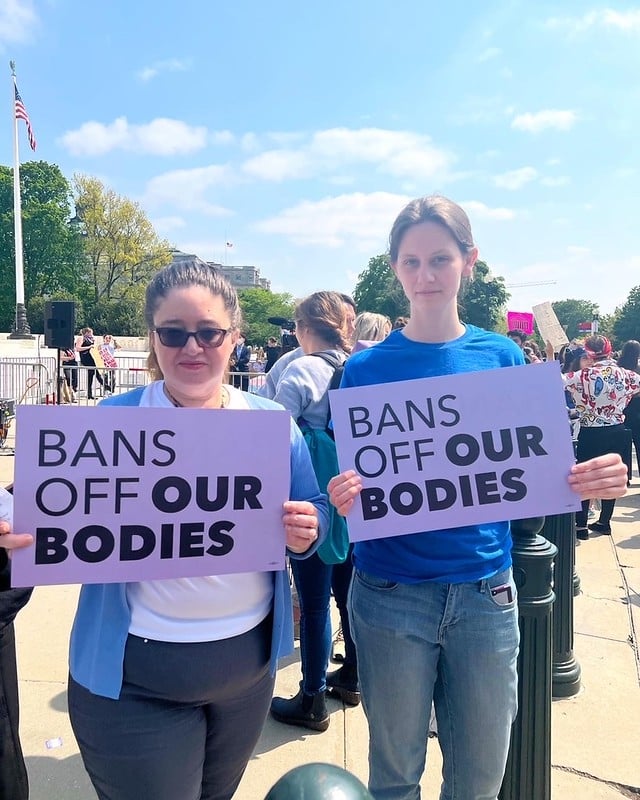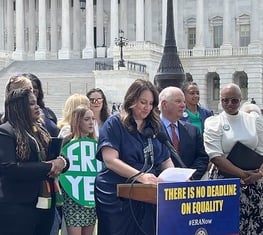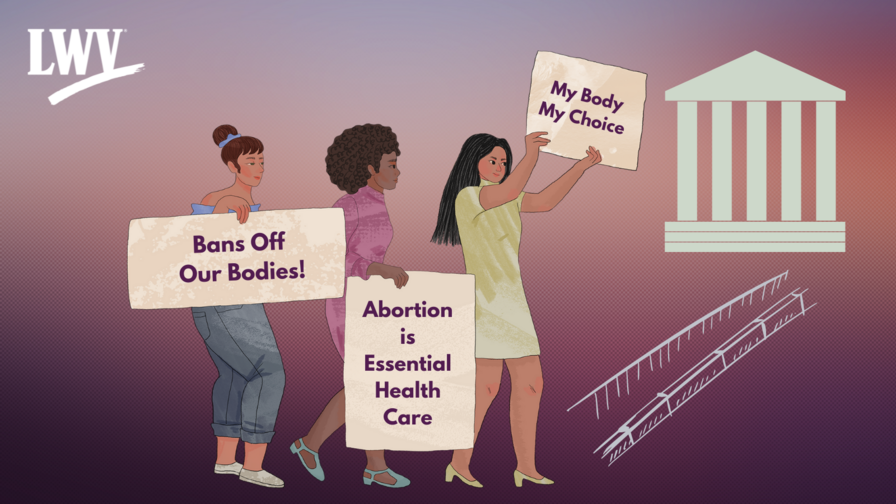Mifepristone: Where Things Stand in the Legal Battle Over Medication Abortion
This blog was written by 2023 legal intern Sarah Tibbitts and staff attorney Thomas Tai. It was then updated in June 2024 by legal intern Avery Emery.
Mifepristone, a drug commonly used for medication abortion, is under attack in the federal courts. At stake are the rights of women and people who can become pregnant to access one of the most common, effective, and safest forms of abortion. Read on to learn where the case challenging FDA approval of the drug stands today.
What Is Medication Abortion?
Before jumping to the status of the case, let’s talk about medication abortion itself.
Over half of all abortions in the United States are medication abortions. Medication abortions typically consist of two pills — mifepristone and misoprostol — which work together to end early pregnancies by blocking the hormone progesterone. Mifepristone received full approval from the Food and Drug Administration (FDA) in 2000 and has been approved to end a pregnancy through the first ten weeks. Abortion medications are incredibly effective in ending early pregnancies, with success rates of 94 – 98% when used correctly in the first eight weeks of pregnancy. Abortion medications are also very safe when used as directed; follow-ups are required less than 1% of the time. There is also a lower risk of complications from medication abortions than procedural abortions or childbirth and a lower risk of death than the common antibiotic penicillin.
Learn about LWV's work towards reproductive justice and other issues in your community through your local League.
But the future of medication abortion is uncertain, as lawmakers increasingly target mifepristone use to curb, if not fully block, abortion access. The fight against medication abortion came to the forefront this year as both the US Court of Appeals for the Fifth Circuit and the United States Supreme Court heard arguments about access to mifepristone.
When the US Supreme Court ruled in Dobbs v. Jackson Women’s Health Organization that the US Constitution does not confer a right to abortion, the Court overturned decades of precedent from Roe v. Wade and Planned Parenthood v. Casey. Medication abortion’s legality and availability now depend on individual state laws, despite the FDA’s longstanding approval of mifepristone.
The Case Against Mifepristone: Alliance for Hippocratic Medicine v. FDA
The Alliance for Hippocratic Medicine (AHM) is a collective of anti-abortion organizations that sued to revoke the FDA’s approval of mifepristone in November 2022. AHM claimed mifepristone could lead to complications or “incomplete abortions,” and that health care professionals could be forced to use the drug to treat patients or “complete...abortion[s]” even if it was against their personal moral or religious beliefs. These anti-abortion plaintiffs also claimed that mifepristone received “accelerated approval” by the FDA and thus had not been fully assessed for risks and benefits.

This is false. Mifepristone has been an approved and widely used drug for over two decades since the FDA approved the medication in 2000. It had already been approved by numerous countries, including China, the UK, and Sweden, as early as the late-20th century. Before being approved by the FDA, the drug went through three rounds of reviews over four years.
April 7, 2023: Federal District Court Judges Make Opposing Rulings on Mifepristone
On April 7, 2023, a federal district court judge in Texas in Alliance for Hippocratic Medicine v. FDA revoked the FDA’s approval of mifepristone, declaring the agency had “improperly approved the drug.” Almost immediately thereafter, a federal district court judge in Washington issued a contrary ruling upholding FDA approval of mifepristone. The Biden Administration sought an emergency stay of the Texas district court’s injunction — meaning a pause on the order going into effect immediately.
On April 12, the Fifth Circuit issued a ruling on the emergency stay, partially pulling back on the Texas ruling while still placing some limitations on the availability of mifepristone. This decision was based on the statute of limitations for challenging the FDA’s approval of mifepristone having long run out.
The Fifth Circuit ruled that mifepristone could continue to be used, but only through seven weeks of pregnancy — despite the FDA’s approval of usage through ten weeks of pregnancy. In addition, the Fifth Circuit order would require the FDA to reinstate several old restrictions on mifepristone that had been removed in 2016.
Further, under the Fifth Circuit’s order, mifepristone could not be prescribed by mail, and recipients had to physically travel to a doctor’s office to receive the medication. This created an additional barrier for people without cars, patients in rural areas, and working people for whom visiting a doctor’s office during the day is highly inconvenient and time-consuming.
April 21, 2023: The Supreme Court Weighs In
On behalf of the FDA, the federal government sought an emergency stay of the Fifth Circuit’s ruling to the United States Supreme Court. On April 21, 2023, the Supreme Court stayed the district court’s preliminary injunction.
In doing so, the Court blocked the two lower court decisions that would have immediately limited access to mifepristone, maintaining the status quo for now — and leaving the case in the hands of the Fifth Circuit Court of Appeals. Justices Thomas and Alito dissented, stating they would have denied the stay of the lower courts’ decisions, immediately removing access to mifepristone.
May 17, 2023: Fifth Circuit Hears Arguments for Temporarily Pulling Mifepristone Off Market
On May 17, 2023, a Fifth Circuit panel made up of different judges than the emergency hearing heard oral arguments about mifepristone’s availability.

August 16, 2023: Fifth Circuit Rules
On August 16, 2023, the three-judge panel of the US Court of Appeals for the Fifth Circuit, which heard oral arguments in May, issued its ruling. In a 2 – 1 vote, the panel ruled that the plaintiffs’ challenge to mifepristone’s original approval in 2000 was untimely. However, the panel reinstated several restrictions on mifepristone that the FDA had loosened or abolished in 2016 and 2021.
March 26, 2024: Supreme Court Hears Oral Arguments
On March 26, 2024, the US Supreme Court heard oral arguments in the federal government’s appeal of the Fifth Circuit ruling. As noted above, the Supreme Court had previously paused the effects of the Fifth Circuit’s decision while the appeal was pending, leaving access to mifepristone in place.
Many of the Justices seemed skeptical of AHM’s arguments that it had the right to challenge the FDA’s actions in court. Justices Alito and Thomas, however, expressed some concern over the federal government’s inability to identify an alternative party that would have the right to sue the FDA over its decision to loosen mifepristone’s restrictions.
June 13, 2024: Supreme Court Rules
On June 13, 2024, the US Supreme Court issued a unanimous decision, holding that AHM lacked standing (the right of a party to sue in court) to challenge the FDA’s actions. This decision preserves access to mifepristone.
For a party to sue in court, they must meet three requirements:
- A party must have been injured in some way;
- That injury must be “traceable” to the party they are suing (i.e. the injury is that party’s fault); and
- The court must be able to remedy the injury, perhaps by awarding monetary damages to the wronged party or, as AHM requested in this case, by reinstating restrictions on mifepristone.
If a party is not able to prove all three of these requirements, their case must be dismissed.
To prove they met the above requirements, AHM raised several arguments connecting the FDA’s 2016 and 2021 actions to AHM’s alleged injuries. AHM’s first argument was that the FDA’s loosened mifepristone restrictions would lead to individual doctors suffering “conscience injuries” because they could be forced to provide emergency abortions against their will. In their view, the FDA’s looser restrictions on the drug would lead to more pregnant people suffering from medication abortion-related complications. This would lead more people to require emergency abortions, which doctors may be forced to perform. The Supreme Court rejected this argument, noting that, even if more patients required emergency abortions, federal law protects doctors from performing abortions or providing other treatments that violate their conscience.

Second, AHM argued that doctors will incur economic injuries from increased access to mifepristone. As with their first argument, this one rests on an assumption that relaxed restrictions on mifepristone will lead to more complications that the doctors must address, diverting time and resources from their other patients. All of this, according to AHM, will lead to an increased risk of liability and, in turn, increased insurance costs for the doctors who are members of AHM. The Supreme Court rejected this argument, finding that it was too speculative. The Court noted, for example, that none of the doctors could point to a single instance in which they were sued or had increased insurance costs due to treating a patient who had taken mifepristone.
Finally, AHM argued that it had standing to sue the FDA because the FDA’s actions burdened AHM’s ability to achieve their mission. For example, because the FDA approved mifepristone, AHM devoted resources to conducting studies to inform its members of the supposed dangers of mifepristone and drafting citizen petitions. These actions came at the expense of the organization’s other priorities. However, the Supreme Court was unconvinced by this argument, finding that an organization cannot “manufacture its own standing” by spending “money to gather information and advocate against the defendant’s action.”
In sum, the Supreme Court found that the above arguments failed to show a connection between AHM’s alleged injuries and the FDA’s actions strong enough to prove that AHM had the right to sue the FDA in this case.
Stay Updated
Keep up with the League and our work around democracy and reproductive justice.
What Does This All Mean for Access to Mifepristone?
The Supreme Court’s decision in FDA v. Alliance for Hippocratic Medicine is a win for reproductive justice and bodily autonomy. Mifepristone remains available nationwide under the guidelines set by the FDA in 2021. While it is important to celebrate wins as they come, it is critical to stay vigilant about other restrictions and decisions around reproductive choice and health care access. Seventeen states have restricted access to mifepristone. These stats have passed laws limiting who can provide mifepristone, mandating in-person appointments, and banning the mailing of mifepristone.
Meanwhile, Roe v. Wade remains overturned, and there is still no recognized federal right to abortion. Many states are facing legal challenges, such as abortion bans (also in June, the Supreme Court will be issuing a decision in the case United States v. Idaho challenging Idaho’s ban on providing emergency abortions), and many nationwide clinics that provide abortion services have closed.
Further, because the Court did not rule on the exact issue in the case — the legality of the FDA’s actions on mifepristone — it is likely that anti-abortion crusaders will seek to revive the challenge with a different set of challengers.

What Can I Do?
To support abortion seekers and providers directly, you can donate to local abortion funds. Many desperately need financial support; if you cannot give financially, reach out and see if you can help as an in-person volunteer.
You can also support abortion rights by voting for politicians who value reproductive freedom. Some states also have ballot initiatives around abortion access. Ensure your voter registration is updated, you know what issues are on the ballot, and you have the proper ID you need to vote in your state. Check your registration and find out where your candidates stand at VOTE411.org.
Contact your representatives! Let them know you’re passionate about safe and accessible reproductive health care for everyone.
The Latest from the League
From January – August 2023, state legislatures nationwide passed various bills into law. While following these developments, the League noticed several important trends around voting rights and election administration.
There is only one way we can ensure that the promise of democracy is kept: by fervently participating in our nation’s political processes, ensuring our voices are heard.
Without the ability to make reproductive decisions for one’s body, those who can become pregnant cannot participate equally in our democracy.
Further, since the Dobbs decision reversing the right to abortion, numerous state governments have introduced legislation directly or indirectly related to reproductive rights, challenging doctrines of US democracy.
Sign Up For Email
Keep up with the League. Receive emails to your inbox!
Donate to support our work
to empower voters and defend democracy.






